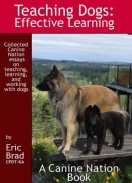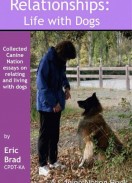 Behaviour is a funny word. What does it mean when our dog “behaves”? The most common use I see is when dog owners use it to mean that their dog is not getting into trouble; the dog is “behaving” itself. For those of us who are into more formal dog training, “behave” might mean an action that my dog performs. An example would be if I asked my dog to “shake a paw”, the behaviour is that she raises her right paw. So when we teach our dog a behaviour, we are really teaching it to perform a specific action that we can see. They either do it or they don’t.
Behaviour is a funny word. What does it mean when our dog “behaves”? The most common use I see is when dog owners use it to mean that their dog is not getting into trouble; the dog is “behaving” itself. For those of us who are into more formal dog training, “behave” might mean an action that my dog performs. An example would be if I asked my dog to “shake a paw”, the behaviour is that she raises her right paw. So when we teach our dog a behaviour, we are really teaching it to perform a specific action that we can see. They either do it or they don’t.We teach lots of behaviours to our dogs – Sit, Down, Come, Shake A Paw, and many more. But from time to time we need to teach our dogs to “not do” something like picking food up off of the floor or running out the door before we are ready. It’s easy to understand what we mean when we ask a dog to DO something but what does it mean for a dog to NOT-DO something? Is there a way we can see it when our dog chooses to NOT-DO something?
Marking a choice
When I was learning Mark & Reward training, one of the most difficult concepts for me to understand was marking the choice my dog was making. If I was training my dog to sit, I could mark the moment when my dog put her butt on the floor but it would be even better for the training if I could mark the moment that she DECIDED to put her butt on the floor. Seeing the movement of my dog’s body is much easier to do that seeing her make a choice to do something. But, like most things in Mark & Reward training, learning to see my dog making a choice is a skill that I learned to get better at over time.
Sometimes it was a look in her eyes, sometimes it was a twitch of a muscle that signalled that she was responding to my instruction, but there were always small outward physical signs that my dog had decided to do the thing I was asking her to do. It was just a matter of improving my observation skills and learning to read my dog.
I suppose the underlying message here is that “making a choice” should be considered a behaviour in itself. After all, choosing to do something is a thing that my dog does just like sitting or lying down. While it might sound a bit like splitting hairs, to me it is just as important that my dog is choosing to cooperate with me. Just getting the result I want is not enough.
Choosing to refrain
If all of our dog’s observable behaviours begin with an internal “choose an action” behaviour, can our dog also choose NOT to take an action? This can be tricky for us in dog training because we can’t really be sure we see the results of our dog choosing to NOT do something. How can we know that they have done the “choose an action” behaviour? This is what the behaviourist approach to learning calls “The Black Box” problem. We cannot know the internal working of the dog’s thinking. We can only see how the dog behaves.
In the 1960s, researchers at Stanford University wanted to get a better understanding of why some children were impatient while others could wait patiently. They devised what has been called “The Marshmallow Experiment.” In short, the experiment involved offering a child the choice between one small reward provided immediately or two small rewards if they waited for approximately 15 minutes. The reward might be a marshmallow, a cookie, or a pretzel; something the child would enjoy. The adult tester would leave the room and then return. Interestingly, a majority of the children in the original study could wait for the additional reward.
 Essentially, the children were presented with a reward but were asked to “not-do” something in order to get a greater reward. That sounds a lot like some of the things I need to teach my own dogs. The interesting research resulting from the original Stanford study showed that the children who were able to wait for the additional reward, to delay their gratification, went on to have greater successes in life including better career outcomes, higher academic test scores, greater achievement in education, and healthier lifestyles. So learning to refrain from doing things can have a positive impact on life skills. But the research did not stop there.
Essentially, the children were presented with a reward but were asked to “not-do” something in order to get a greater reward. That sounds a lot like some of the things I need to teach my own dogs. The interesting research resulting from the original Stanford study showed that the children who were able to wait for the additional reward, to delay their gratification, went on to have greater successes in life including better career outcomes, higher academic test scores, greater achievement in education, and healthier lifestyles. So learning to refrain from doing things can have a positive impact on life skills. But the research did not stop there.Don’t-Do behaviours
What does it look like when my dog is refraining from behaviour? Well, the easiest and most obvious thing most dog owners teach their dog is a “Wait” or “Stay” behaviour. When we go to the front door, we don’t want our dogs running outside because there could be traffic. So we teach them to “wait”, to not go anywhere until I tell them it’s ok to head out. I say “Wait” and open the door. My dog should stay in place, not do anything, until I give them the ok. In reality, my dog CHOOSES to not do anything; a behaviour in itself.
Like the “Marshmallow Experiment”, I have to teach my dogs that there will be reward for refraining from behaviour when I ask. After all, the great outdoors are right THERE; why would my dog wait? In my case, the promise is that if you can wait for a short time, you get to go outside AND get a nice food treat. It’s a system that has worked with dogs for centuries. There really isn’t anything revolutionary about teach a dog to “wait.”
We teach our dogs other “don’t-do” behaviours as well. “Leave it” is our all purpose cue for our dogs to not investigate or pick up something. It could be food or a toy or even a dead mouse. Another behaviour many owners teach is “settle” or “wait on your mat” behaviour where the dog will be asked to lay down on a mat or in a specific spot and not get up until given the ok.
Trust me
A later version of the original Stanford experiment was run in which half of the children who were promised the extra reward got it while the other half were lied to and told that there was no extra reward at the end of the experiment. When the researchers ran the experiment with the subjects a second time, those who received the promised extra reward in the first round again waited patiently. But those who were lied to in the first round immediately ate the reward they were given and did not wait. Apparently trust is a major factor in being willing to refrain from a behaviour. If you don’t trust that the waiting will produce a good outcome, you won’t wait.
Dog trainers often talk about the importance of being consistent with your dog in training in order to get the behaviours you want and for the dog to do them reliably. It also appears that being consistent is a critical factor in whether your dog can refrain from doing unwanted behaviours as well. Don’t-do behaviours may be even more sensitive to inconsistent rewards than the behaviours where we ask our dogs to do something.
Learning to refrain
Waiting for that extra reward isn’t easy for our dogs. But the Stanford Marshmallow experiment is important because it was done with children. The results of this research are relevant to the limited intelligence of our dogs. Like the subjects in the study, our dogs often come into our lives not knowing how things work and they have to trust us to give them what they need to be successful in our world. So while there may be a biological component to how well my dog can control her impulses and urges, the science shows that there is a lot I can do to help her develop the skills to be a patient and calm learner and to refrain from behaviours when asked.
 There are a few simple guidelines we have found useful in teaching our dogs these “don’t-do” behaviours. The first is to start small and make it easy to succeed. I can’t begin to teach my dog that it will pay off to wait if I start by making her wait for 30 minutes for a reward. There is just too much time to start to question if the payoff will ever come. So we start by asking only for a few second before the reward and then gradually increase the wait time. We are always careful never to let our dogs get uncomfortable or frustrated with the waiting because that can erode the trust we have tried to develop with our dogs. We have found that it’s best to take it slow and keep the success rate very high. Occasional mistakes are quickly and easily forgotten this way.
There are a few simple guidelines we have found useful in teaching our dogs these “don’t-do” behaviours. The first is to start small and make it easy to succeed. I can’t begin to teach my dog that it will pay off to wait if I start by making her wait for 30 minutes for a reward. There is just too much time to start to question if the payoff will ever come. So we start by asking only for a few second before the reward and then gradually increase the wait time. We are always careful never to let our dogs get uncomfortable or frustrated with the waiting because that can erode the trust we have tried to develop with our dogs. We have found that it’s best to take it slow and keep the success rate very high. Occasional mistakes are quickly and easily forgotten this way.Another important factor is to be realistic. It’s important to stay aware of where my dog is in her “don’t-do” skill development. I don’t want to ask her to refrain from a behaviour when the alternative is too enticing or rewarding. There are going to be things that my dog just can’t resist at her current level of training. It’s better that I don’t put her in a difficult situation. If an unexpected situation happens, it’s better for me not to ask them to refrain and do more training work later.
Can a dog learn to “not-do” something? Of course they can. It’s a concept they learn as part of life skills like not pestering the older dog or you will get snapped at. Can I TEACH my dog to “not-do” something? Yes I can. It’s not hard but it requires me to be consistent, honest, and generous in my rewards. I need to be careful not to ask my dog for more patience than they have learned at any given point. In the end, my dogs will “not-do” all kinds of things just because I asked and not because they will be punished if they do. Teaching my dog to “Not-Behave” in particular ways has made life better for both of us. It’s just a matter of keeping the right expectations and teaching the right skills.
Until next time, have fun with your dogs!
Be sure to check out our Canine Nation ebooks on Amazon, Google, Dogwise, and other ebook sellers. Join our conversation on Facebook in the Canine Nation Forum!
These Canine Nation ebooks are now available –



Available from Dogwise!
Photo credits –
Boxer- copyright Cuatrok77 2014
Ball- copyright Alexander Day 2016
Smile- copyright Sonja Lovas 2007
Stay (Featured Image) – copyright Eric de Boer 2018



Available from Dogwise!
Photo credits –
Boxer- copyright Cuatrok77 2014
Ball- copyright Alexander Day 2016
Smile- copyright Sonja Lovas 2007
Stay (Featured Image) – copyright Eric de Boer 2018
